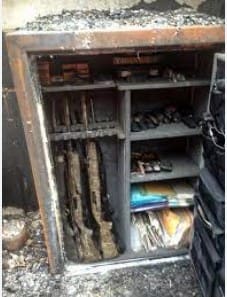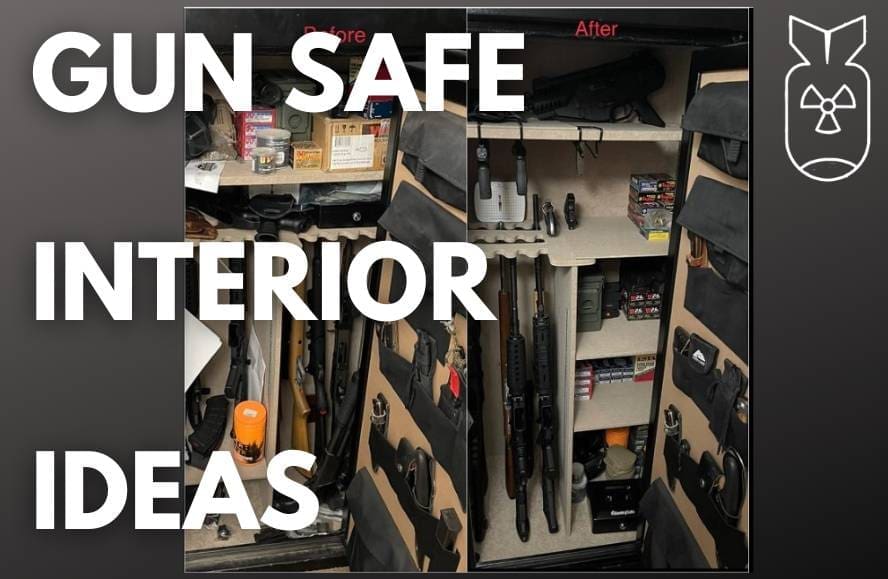So, the million-dollar question today is: Are gun safes fireproof? Well, hold onto your holsters folks because we’ll be diving deep into this firey topic (answer incoming, I promise!).
Imagine you’ve bought all your dream firearms, invested in some cool accessories, and now you’re about ready to have John Wick hold your beer—respectfully, of course!
But before you go unplugging from the Matrix, may I inquire as to how you plan on storing your growing arsenal? It’s a dilemma all gun owners face at some point in time… the desire to own a secure gun safe solution, but are any of them truly fireproof?


The Myth of ‘Fireproof’ Safes
Let’s clear the air first and foremost because it’s crucial to acknowledge that no gun safe made today, can claim to be 100% fireproof- not a single one. -Full Stop- And, if there happens to be someone who dares to tell you otherwise… well, they’re likely just trying to pull a fast one on you.


Trust me on this, I’ve been deeply entrenched in this industry for years, long enough to realize that the term ‘fireproof’ is nothing more than a clever marketing ploy rather than a scientifically backed statement.
While some manufacturers may adore casually tossing around this term like confetti, don’t let their flashy claims blind you from the truth. Oh no, it’s far more intricate and complex than that, my fellow firearm enthusiasts!
So let’s take a moment to dig deeper and unravel the layers of this “smoke-and-mirrors game.”
Understanding Fire Ratings
Alright, ladies and gentlemen, gather ’round, because it’s time for us to delve into the fascinating world of Fire Ratings 101. You see, when it comes to gun safes, they often come equipped with fire ratings that serve as a measure of how long these safes can effectively shield their precious contents when faced with intense temperatures.
However, brace yourselves, for here’s the twist that might just blow your mind… There exists no universally accepted standard for these ratings!
Yes, you read that right. What you may not know is manufacturers have the liberty to conduct in-house testing on these safes and their testing methods can range from adorable and endearing to downright rigorous and vigorous. Quite a diverse spectrum indeed!
As an illustration, let’s dive a bit deeper into the topic of fire ratings. Merely having a 30-minute fire rating at 1,400°F does not guarantee that your prized AR-15 will emerge unscathed without even a single mark.
It is important to take into account several other crucial factors, including the ambient room temperature, the specific placement of the safe, and the level of insulation it possesses.
As a consequence, it is unwise to treat these ratings as indisputable truths or absolute gospel, as they ought to be regarded as more flexible guidelines, subject to the intricacies and variables of real-world scenarios.
What To Look For:
If you want to increase the odds of protecting your firearms from heat damage, look for safes with actual UL-certified fire resistance- as shown below (the longer the resistance, the better).


What’s Inside the Safe Matters!
You can’t simply disregard the importance of properly safeguarding your ammunition and cherished family heirlooms by haphazardly stashing them inside any old gun safe and thinking the job has been done.
It is important to acknowledge that diverse materials possess distinct melting points, implying that certain objects may potentially endure irreversible harm, even if the safe’s external casing exhibits exceptional resilience.
To illustrate this point further, let’s envisage that you have securely kept some of your favorite polymer-framed pistols within your safe. Despite the chance that the safe might emerge unscathed, the intense heat could undeniably wreak havoc on these delicate yet aesthetically pleasing polymer pistols.
When evaluating your options for a secure storage solution, it is important to seriously contemplate what precisely you intend to store and how inherently vulnerable those particular items are to the damaging effects of heat.
It goes without saying (but I’ll say it anyway), that not all fireproof safes are created equal. More competent (and expensive) designs that disconnect the metal frame from the interior walls do a much better job of creating a buffer zone between the hot exterior and the interior… thus keeping the temperature inside to a minimum.
Considerations for Fireproofing
If you happen to find yourself in possession of a surplus amount of cash that is just begging to be spent, a clever solution would be to put on your investor hat and direct those funds toward acquiring a top-tier gun safe.


Now, it’s crucial to opt for a safe that boasts multiple layers of fire-resistant material like gypsum board, ensuring that your hard-earned currency will survive unscathed even in the face of raging flames. External hinges are extremely important too since they keep those thick metal hinges from transferring heat inside your safe.
Remember, the thicker the lining, the higher the degree of protection it offers… turning it into an impenetrable fortress safeguarding your valuable possessions.
To amplify the level of security, it’s advisable to carefully select a location for your safe that is situated far from any flammable items, preventing potential disaster and guaranteeing some additional peace of mind.
For those who strive for absolute perfection and refuse to settle for anything less, some individuals even take it upon themselves to go above and beyond by installing an elaborate sprinkler system directly above their precious safe… now that’s what I call forward thinking!
Final Thoughts
If you’re looking for budget-friendly options, fire-resistant document bags inside a basic gun safe are a cheaper but less effective alternative. You could also bury your safe underground, but don’t go full pirate on me, okay? At the end of the day, no gun safe is truly “fireproof” but many are “fire-resistant” (some more than others).
Do your homework, scrutinize those fire ratings, and understand the value proposition compared to safes above and below that price point. And always remember, you’re not just protecting your firearms, but also the investment… not to mention the emotional value attached to them.



